AMD's Radeon HD 5870: Bringing About the Next Generation Of GPUs
by Ryan Smith on September 23, 2009 9:00 AM EST- Posted in
- GPUs
Cypress: What’s New
With our refresher out of the way, let’s discuss what’s new in Cypress.
Starting at the SPU level, AMD has added a number of new hardware instructions to the SPUs and sped up the execution of other instruction, both in order to improve performance and to meet the requirements of various APIs. Among these changes are that some dot products have been reduced to single-cycle computation when they were previously multi-cycle affairs. DirectX 11 required operations such as bit count, insert, and extract have also been added. Furthermore denormal numbers have received some much-needed attention, and can now be handled at full speed.
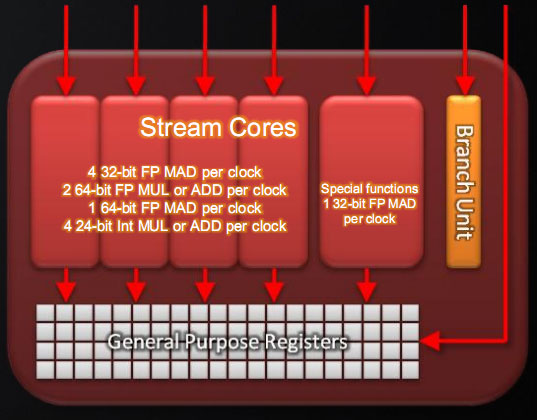
Perhaps the most interesting instruction added however is an instruction for Sum of Absolute Differences (SAD). SAD is an instruction of great importance in video encoding and computer vision due to its use in motion estimation, and on the RV770 the lack of a native instruction requires emulating it in no less than 12 instructions. By adding a native SAD instruction, the time to compute a SAD has been reduced to a single clock cycle, and AMD believes that it will result in a significant (>2x) speedup in video encoding.
The clincher however is that SAD not an instruction that’s part of either DirectX 11 or OpenCL, meaning DirectX programs can’t call for it, and from the perspective of OpenCL it’s an extension. However these APIs leave the hardware open to do what it wants to, so AMD’s compiler can still use the instruction, it just has to know where to use it. By identifying the aforementioned long version of a SAD in code it’s fed, the compiler can replace that code with the native SAD, offering the native SAD speedup to any program in spite of the fact that it can’t directly call the SAD. Cool, isn’t it?
Last, here is a breakdown of what a single Cypress SP can do in a single clock cycle:
- 4 32-bit FP MAD per clock
- 2 64-bit FP MUL or ADD per clock
- 1 64-bit FP MAD per clock
- 4 24-bit Int MUL or ADD per clock
- SFU : 1 32-bit FP MAD per clock
Moving up the hierarchy, the next thing we have is the SIMD. Beyond the improvements in the SPs, the L1 texture cache located here has seen an improvement in speed. It’s now capable of fetching texture data at a blistering 1TB/sec. The actual size of the L1 texture cache has stayed at 16KB. Meanwhile a separate L1 cache has been added to the SIMDs for computational work, this one measuring 8KB. Also improving the computational performance of the SIMDs is the doubling of the local data share attached to each SIMD, which is now 32KB.
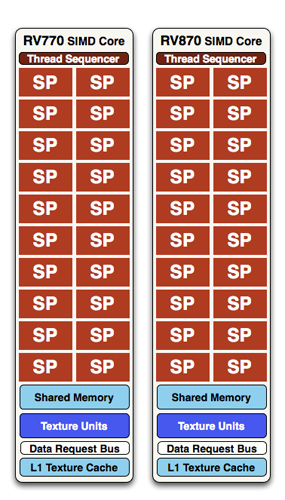
At a high level, the RV770 and Cypress SIMDs look very similar
The texture units located here have also been reworked. The first of these changes are that they can now read compressed AA color buffers, to better make use of the bandwidth they have. The second change to the texture units is to improve their interpolation speed by not doing interpolation. Interpolation has been moved to the SPs (this is part of DX11’s new Pull Model) which is much faster than having the texture unit do the job. The result is that a texture unit Cypress has a greater effective fillrate than one under RV770, and this will show up under synthetic tests in particular where the load-it and forget-it nature of the tests left RV770 interpolation bound. AMD’s specifications call for 68 billion bilinear filtered texels per second, a product of the improved texture units and the improved bandwidth to them.
Finally, if we move up another level, here is where we see the cause of the majority of Cypress’s performance advantage over RV770. AMD has doubled the number of SIMDs, moving from 10 to 20. This means twice the number of SPs and twice the number of texture units; in fact just about every statistic that has doubled between RV770 and Cypress is a result of doubling the SIMDs. It’s simple in concept, but as the SIMDs contain the most important units, it’s quite effective in boosting performance.
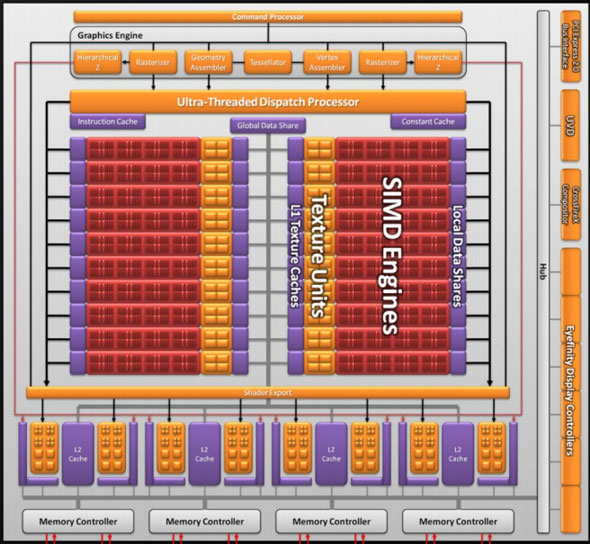
However with twice as many SIMDs, there comes a need to feed these additional SIMDs, and to do something with their products. To achieve this, the 4 L2 caches have been doubled from 64KB to 128KB. These large L2 caches can now feed data to L1 caches at 435GB/sec, up from 384GB/sec in RV770. Along with this the global data share has been quadrupled to 64KB.
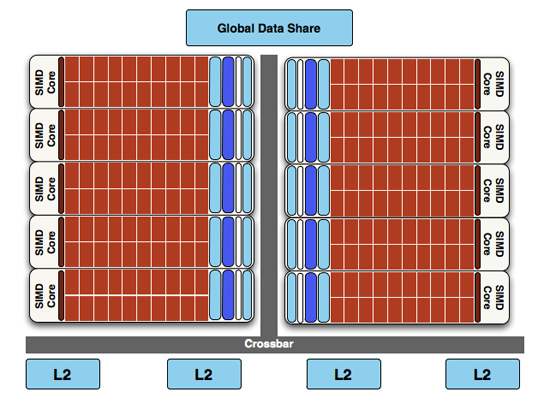
RV770 vs...
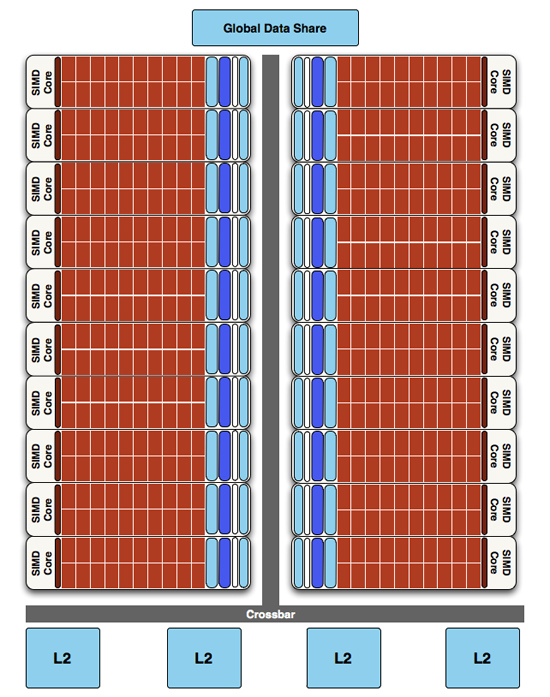
Cypress
Next up, the ROPs have been doubled in order to meet the needs of processing data from all of those SIMDs. This brings Cypress to 32 ROPs. The ROPs themselves have also been slightly enhanced to improve their performance; they can now perform fast color clears, as it turns out some games were doing this hundreds of times between frames. They are also responsible for handling some aspects of AMD’s re-introduced Supersampling Anti-Aliasing mode, which we will get to later.

Last, but certainly not least, we have the changes to what AMD calls the “graphics engine”, primarily to bring it into compliance with DX11. RV770’s greatly underutilized tessellator has been upgraded to full DX11 compliance, giving it Hull Shader and Domain Shader capabilities, along with using a newer algorithm to reduce tessellation artifacts. A second rasterizer has also been added, ostensibly to feed the beast that is the 20 SIMDs.










327 Comments
View All Comments
Wreckage - Wednesday, September 23, 2009 - link
Hot, loud, huge power draw and it barely beats a 285.A disappointment for sure.
SiliconDoc - Thursday, September 24, 2009 - link
Thank you Wreckage, now, I was going to say draw up your shields, but it's too late, the attackers have already had at it.--
Thanks for saying what everyone was thinking. You are now "a hated fanboy", "a paid shill" for the "corporate greedy monster rip off machine", according to the real fanboy club, the ones who can't tell the truth, no matter what, and prefer their fantasiacal spins and lies.
Zstream - Wednesday, September 23, 2009 - link
They still allow you to post?yacoub - Wednesday, September 23, 2009 - link
He's right in the first sentence but went all fanboy in the second.Griswold - Wednesday, September 23, 2009 - link
Not really, he's a throughbred fanboy with everything he said. Even on the "loud" claim compared to what previous reference designs vom ATI were like...SiliconDoc - Wednesday, September 30, 2009 - link
So if YOU compare one loud design of ati's fan to another fan and as loud ati card( they're all quieter than 5870* but we'll make believe for you for now),
and they're both loud, anyone complaining about one of them being loud is "an nvidia fanboy" because he isn't aware of the other loud as heck ati cards, which of course, make another loud one "just great" and "not loud". LOL
It's just amazing, and if it was NV:
" This bleepity bleep fan and card are like a leaf blower again, just like the last brute force monster core power hog but this **tard is a hurricane with no eye."
But since it's the red cards that are loud, as YOU pointed out in the plural, not singular like the commenter, according to you HE's the FANBOY, because he doesn't like it. lol
ULTIMATE CONCLUSION: The commenter just told the truth, he was hoping for more, but was disappointed. YOU, the raging red, jumped his case, and pointed out the ati cards are loud "vom" prior.. and so he has no right to be a big green whining fanboy...
ROFLMAO
I bet he's a "racist against reds" every time he validly criticizes their cards, too.
---
the 5870 is THE LOUDEST ATI CARD ON THE CHART,AND THE LOUDEST SINGLE CORE CARD.
--
Next, the clucking rooster will whiplash around and flap the stubby wings at me, claiming at idle it only draws 27 watts and is therefore quiet.
As usual, the sane would them mention it will be nice not playing any 3d games with a 3d gaming card, and enjoying the whispery hush.
--
In any case:
Congratulations, you've just won the simpleton's red rooster raving rager thread contest medal and sarcastic unity award.(It's as real as any points you've made)
Anyhow thanks, you made me notice THE 5870 IS THE LOUDEST CARD ON THE CHARTS. I was too busy pointing out the dozen plus other major fibboes to notice.
It's the loudest ati card, ever.
GourdFreeMan - Wednesday, September 23, 2009 - link
I thought the technical portion of your review was well written. It is clear, concise and written to the level of understanding of your target audience. However, I am less than impressed with your choice of benchmarks. Why is everything run at 4xAA, 16xAF? Speaking for most PC gamers, I would have maxed the settings in Crysis Warhead before adding AA and AF. Also, why so many console ports? Neither I, nor anyone else I personally know have much interest in console ports (excluding RPGs from Bethesda). Where is Stalker: Clear Sky? As you note its sequel will be out soon. Given the short amount of time they had to work with DX11, I imagine it will run similarly to Stalker: Call of Pripyat. Also, where is ArmA II? Other than Crysis and Stalker it is the game most likely to be constrained by the GPU.I don't want to sound conspiratorial, but your choice of games and AA/AF settings closely mirror AMD's leaked marketing material. It is good that you put their claims to the test, as I trust Anandtech as an unbiased review site, but I don't think the games you covered properly cover the interests of PC gamers.
Ryan Smith - Wednesday, September 23, 2009 - link
For the settings we use, we generally try to use the highest settings possible. That's why everything except Crysis is at max quality and 4xAA 16xAF (bear in mind that AF is practically free these days). Crysis is the exception because of its terrible performance; Enthusiast level shaders aren't too expensive and improve the quality more than anything else, without driving performance right off a cliff. As far as playing the game goes, we would rather have AA than the rest of the Enthusiast features.As for our choice of games, I will note that due to IDF and chasing down these crazy AA bugs, we didn't get to run everything we wanted to. GRID and Wolfenstein (our OpenGL title) didn't make the cut. As for Stalker, we've had issues in the past getting repeatable results, so it's not a very reliable benchmark. It also takes quite a bit of time to run, and I would have had to drop (at least) 2 games to run it.
Overall our game selection is based upon several factors. We want to use good games, we want to use popular games so that the results are relevant for the most people, we want to use games that give reliable results, and ideally we want to use games that we can benchmark in a reasonable period of time (which means usually having playback/benchmark tools). We can't cover every last game, so we try to get what we can using the criteria above.
GourdFreeMan - Thursday, September 24, 2009 - link
Popularity and quality are strong arguments for World of Warcraft, Left 4 Dead, Crysis, Far Cry, the newly released Batman game... and *maybe* Resident Evil (though it is has far greater popularity among console gamers). However, HAWX? Battleforge? I would never have even heard of these games had I not looked them up on Wikipedia. In retrospect I can see you using Battleforge due to it being the only DirectX 11 title, but I still don't find your list of games compelling or comprehensive.To me *PC* gaming needs to offer something more than simple action to justify its cost of entry. In the past this included open worlds, multiplayer, greater graphical realism and attempts at balancing realistic simulation with entertaining game play. Console gaming has since offered the first two, but the latter are still lacking.
It's games like Crysis, Stalker and ArmA II along with the potential of modding that attract people to PC gaming in the first place...
dvijaydev46 - Wednesday, September 23, 2009 - link
Good review but it would be good if you could also add Steam and Cuda benchmarks. Now you have a common software Mediashow Espresso right?